Now we are well and truly into the season of mists and mellow fruitfulness take heart from our gardening expert, Alison Agnew, there is still much to enjoy in the garden. But there are also things to do.
October Gardening – a time to review
October is the month when we finally have to accept that summer and the best of the growing year has really ended. Yes, there is beauty both in the decay and in the last remaining plants to come into flower but they are flowering in borders that are often sagging with too much foliage and draped in spiders’ webs every morning.
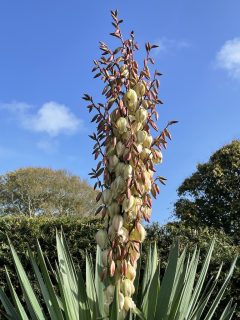
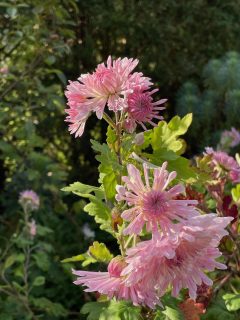
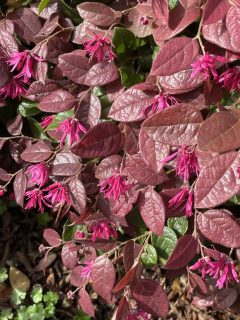
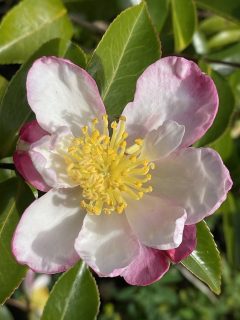


October is a very good time to review – both the last growing year and the overall shape and continuity of the garden.
We have had a tough year; a cold winter brought losses that left gaping holes in the planting; a hot dry early summer exhausted the roses and lawns and delayed the growth of summer perennials; a cold wet July and August left the garden sulking into autumn to be blasted with intermittent heat and high winds.
Climate change models predict yet more unpredictability so what can we do to future-proof our gardens? Over the winter months I’d like to consider potential ways to design our gardens to cope with more extremes.
In Cornwall, particularly in coastal areas, wind is likely to be our biggest enemy. In the past, most storm winds came in from the south west but we seem to be getting strong winds from any direction these days. The February 2014 storm came in from the east and took our garden by surprise – roaring up the valley and felling four trees that were only just into their maturity. Since then we have lost trees and branches from north, west and south winds too. So how can we protect against strong winds?
Living windbreaks
Perhaps we should be planting more shelter-belts and hedges.
Everyone gardening in Cornwall knows the lovely New Zealand coastal plant, Griselinia littoralis. It has bright green, shiny, rounded leaves and grows at an alarming pace. It will grow into a sizeable tree if left to its own devices but is very happy pruned into a hedge. Much as I love it to border a lawn, I think it is just too bright to back a flower border -unless perhaps an elegant all white or blue planting.
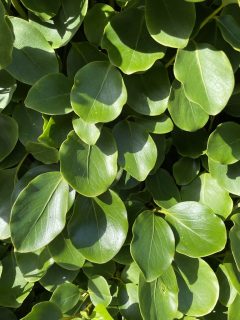
Dark coloured hedges are best for showing off a flowery border and small leaved hedges clipped tightly produce a more architectural background, so Yew (Taxus baccata) and box (Buxus sempervirens) are justifiably popular. Yew is super tough and a brilliant wind filterer. Its only weakness is that it has fleshy roots loved by vine weevil and that suffer in waterlogged ground. Yew is widely believed to be very slow growing but on well drained and fertile soil it really isn’t. My sister on lovely soil near St Hilary grew hers from 30 cm to 2m in just four years – mine have struggled on our poor and soggy soil but have got to 2m in 7 years – with some failures.
No-one in their right mind plants box at the moment with prevalent box blight and the box moth caterpillar on the march towards us. Still, I do continue to try and keep my existing bushes alive and healthy by feeding with blood fish and bone. The proffered alternatives don’t quite do the trick – Ilex crenata is very slow and Lonicera nitida is too fast (and loose).
For large scale wind protection, the Victorian gardeners that established the great valley gardens of Cornwall used a lot of cherry laurel (Prunus laurocerasus) to shelter their exotic tree plantings. It is rapid-growing, evergreen, tough and pretty salt tolerant but generally too large and perhaps too gloomy for domestic gardens.

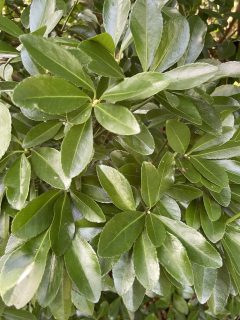
Euonymus japonicus is a good alternative – fast growing and tough with smaller dark glossy green leaves and happy to be pruned hard or left to grow into a tall windbreak. There are many yellow, cream and white variegated forms but generally, I would never use a variegated plant for hedging because I think that splashes and spots detract from any nearby flowers. The one exception I have made in my garden are the quietly variegated forms of Pittisporum tenuifolium in my Silver Border, not grown as a hedge but scattered in the border and clustered closer together where it’s needed as a windbreak. Again, there are many variegated forms but I really only like the white variegated grey-green forms P. tenuifolium Variegatum and P. tenuifolium Silver Queen.
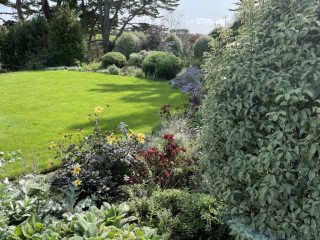
I’d like to make the case for using evergreen bushes as windbreaks within a flower border. Pittisporums are particularly good for this. They can be pruned to keep a dense shape and size and function both to break the wind and to prop up unruly perennials. About 10 years ago Pittisporum tenuifolium Golf Ball came on to the market. This is a form that grows naturally into a ball and only needs a gentle clip twice a year to stay neat at about 1m. There is now both a Silver Ball and a Golden Ball version – both very pretty and worth seeking out. I’ve used them to give structure and rhythm to my rose border and am adding them elsewhere in the garden for propping up summer perennials and for winter structure. Pittisporum eugenoides is more upright, larger leaved and there is a pretty variegated form. Pittisporum Oliver Twist is also a great favourite – upright and vigorous but with tiny glaucous leaves on dark stems – it shimmers in the light.


The rock roses (Cistus) and several species of Hebe, are also solid enough to fulfil the same function and do well in our coastal climate. In a really coast-facing location, a planting of almost exclusively evergreen shrubs and sub-shrubs is a good idea – mimicking the Mediterranean coastal ‘maquis’ vegetation. In addition to Cistus, Hebe spp, myrtles, sages, rosemary and Teucrium spp from Europe, you could add South African Proteas, Coleonema pulchellum and Australian Banksia and Prostanthera spp. that grow in similarly tough locations. Trevena Cross and Lower Kenneggy nurseries are particularly good growers of these tough coastal plants.
Solid windbreaks – walls and fences.
Walled gardens are often envied by people with exposed gardens but walls often cause problems with turbulence that dumps air downwards and flattens border plants. To prevent this, shrubs or small trees should be grown above the height of the wall/fence or a filtering trellis put on top. In our kitchen garden, we placed the netted fruit cage to protect a polytunnel from the wind and attached wind fencing to a gate after losing a greenhouse to wind that funnelled through the gateway in the wall. The answer is to filter the wind – don’t try to block it!
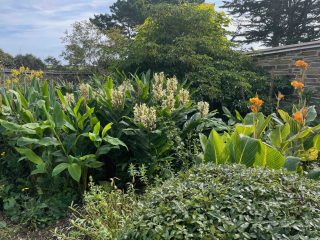
October is a great time to take stock, to review, to cast a critical eye over your garden. It is still in full growth, if not in flower, so you can see whether the shapes and forms work well together, whether there are gaps revealed by late summer die back etc. Photograph your garden this month and look at it critically for form rather than colour. Below is a section of my Hot Garden – holding its form OK in late September but on the left hand side there are too many Hemerocallis and Tigridia which don’t have enough structure at this time leaving a distinct hole in the border. I need to replace some of these grassy leaved plants with a stronger leaf form that develops in late summer – more Cannas probably. There are similar issues in several parts of the garden – I will record them now and hopefully remember to repair them over the autumn and spring.
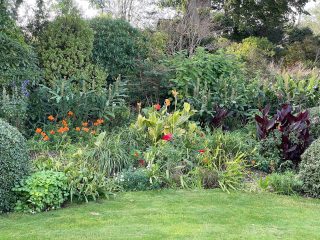
October is a good time to order and plant new trees shrubs and perennials. The ground is still warm and plants will establish before winter. It’s also time to order bare root and root-balled trees, shrubs, roses and hedge plants to plant this winter. These establish so much better than pot-grown plants and are usually cheaper too.
October is also a good time to order and plant spring bulbs. I recommend Parker’s Wholesale for large orders of daffodils, tulips and crocus and Farmer Gracy for more specialist varieties. Look at Sarah Raven’s website for inspiration but check for the same varieties elsewhere at a better price.
Relax – November will (hopefully) bring some rest. Forget the garden – go for a walk on the beach, sit by the fire with the catalogues….


